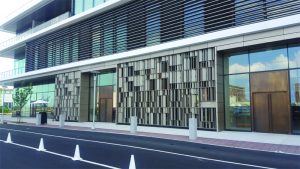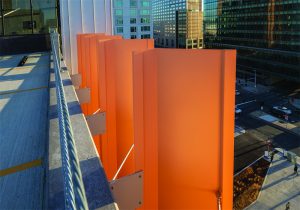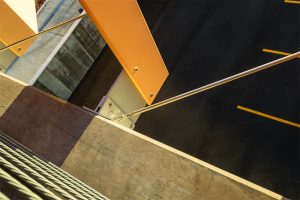Stephen Scharr

Architects seeking to deliver their own, creative signature realize they must focus much of their attention on the design of the exterior wall, the face of the structure to the outside world. It delivers the first impression, defines the building’s personality, and telegraphs its function.
Today’s design trends drive those same architects to source a wide array of applied architectural features that are mounted to the building structure. This includes cantilevered elements that are fully exposed to the elements.
Exterior mounted perforated metal screen walls, grille assemblies, solar shading, applied architectural fins, and other unitized architectural metal assemblies require secure, dynamic, and adjustable structural anchors that are a durable solution for long-term service. Unlike curtain wall assemblies, windows and exterior wall cladding systems, the anchors that are used to attach these features to the building are fully exposed to rain, snow, temperature changes, salt spray, and other environmental elements. Each one of these external forces can accelerate corrosion and adversely affect the structural properties of these components over time. A failing anchor is laden with potential liability for risks to property and personal injury.
Given this, screen walls and unitized architectural assemblies require careful design and material selection (to avoid corrosion risk), so they perform adequately to resist design loads, and to permit the management of varying tolerances in terms of structural and architectural alignment.
For many designs, the anchor clip is also exposed to view and must be an attractive part of the product appearance. If the design is based on a variety of coated aluminum colors, the anchor clips must correlate with that design approach in terms of color and curb appeal.
Proper material selection

From the beginning, it is important to select materials that are compatible with the substrate, environmental conditions, and each other.
In most cases, architectural metal assemblies are comprised of a series of coated aluminum features. Using coated architectural aluminum enables the architect to conduct free expression on the façade, including a vibrant selection of colors and shapes. Usually, a coated aluminum or stainless-steel hardware and anchor clips are preferred to avoid the risk of electrolytic corrosion that can occur between dissimilar metals in the presence of a corrosive solution.

A grille or screen wall assembly includes a myriad of components, and each component should be coated separately prior to assembly to ensure all surfaces are coated. It is critical that all end cuts, milled edges, and clear mounting holes have protection from the elements.
Components that are fabricated from stock-pre-coated sections will have exposed, uncoated edges or metal-to-metal contact surfaces that could be unprotected. These conditions will violate any coating warranty, increase vulnerability to edge creep at the coating/material interface, and could result in a coating failure. The same is true of the anchor clip attachment to the assembly. It is essential these critical components receive the necessary coating after they are fabricated.




